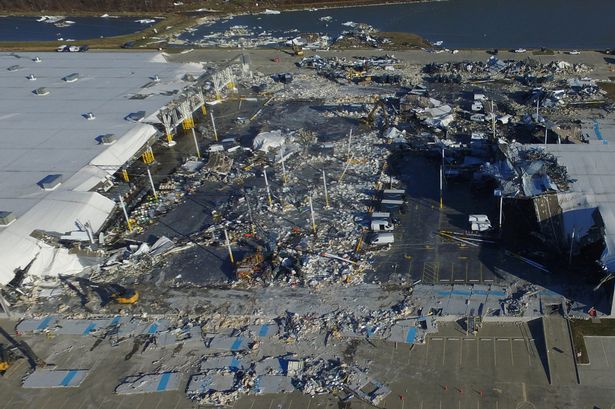By Michael O’Brien
The circumstances in which six Amazon workers recently died, and 95 of their colleagues had to be rescued from a warehouse in Edwardsville, Illinois, which collapsed during a tornado, brings home the fact that the lives of workers are literally at stake when it comes to the task of organising the unorganised.
Those Amazon workers were forbidden by the company, under threat of being fired, from leaving their place of work in sufficient time to shelter with their families from the coming tornado. Company rules also prevented them from having their mobile phones on their person while on the warehouse floor; meaning they could not receive information about the impending disaster.
The same ruthless capitalist logic that led to these workers’ deaths, in the context of an extreme weather event, is what millions of workers in the US and beyond have likewise experienced during the Covid pandemic.
Workers’ lives are dispensable
Some Democrat-controlled administrations have introduced weak attempts to prevent employers from firing workers without any stated cause. These proposed laws, which previously only existed in small pockets around the country, seek to protect workers from being fired for disobeying employers, including when worker health and safety are on the line. Yet these have been met with intense opposition by business groups, with Amazon throwing their weight behind efforts to effectively retain the power to coerce workers into putting their lives at risk.
In the Edwardsville warehouse only seven out of the 190 staff were directly employed full time, with the rest casual agency recruits — a preferred arrangement for a company that fought off a unionising attempt at its warehouse in Bessemer, Alabama. There will be a rerun of the union recognition ballot in Bessemer, as well as a ballot at a warehouse in Staten Island, New York.
These events are occurring in the midst of enormous labour turmoil in the US. The experience of working during the pandemic has been incredibly radicalising for many workers who see first hand the sheer callousness of bosses who resisted lockdown measures that hurt their profits and agitated to get their workers back to work. The same bosses then skimped on health and safety measures.
Growing workers’ unrest
This, combined with a bosses’ offensive to cut pay and conditions in the course of recent months, labour shortages in some sectors and the supply chain crisis have given rise to a highly combustible situation. This is evidenced by the so-called ‘great resignation,’ but also a spate of high profile strikes in the autumn, labelled ‘Striketober.’
An estimated four million workers per month have been quitting their jobs, unable to deal with forced overtime, low pay and general disrespect. Many have shared their quitting on social media to widespread approval. The availability of other jobs, perhaps with slightly better conditions, has made these resignations relatively low-risk for the workers concerned.
While no doubt cathartic, the resignations also highlight how far the labour movement in the US has to go to organise in these workplaces. This is so that workers are not compelled into individual acts, but rather see an alternative in combining with their workmates to force improvements in pay and working conditions.
‘Striketober’
There is no shortage of current and recent examples of the collective approach. ‘Striketober’ saw an estimated 100,000 workers in 43 large workplaces across the country engage in strike action in a number of different sectors including food manufacture, fast food, auto, construction, health and higher education.
While each strike has its own special features, a common denominator has been resistance against employer offensives. Typically these offensives involve introducing and reinforcing two-tier workforces, with newer entrants being put on lower pay and conditions. Among the highest-profile examples have been Kellogg’s, which is ongoing, and the John Deere auto plant.
The other common factor is a general picture of a union leadership unequal to the task and the opportunities posed in the period. Such are the labour shortages that above-inflation pay rises could be realised on the basis of strike campaigns. The experience of UNITE in Britain under Sharon Graham’s leadership is a good example of this, where a higher proportion of strikes have been of an offensive character.
Instead, the strikes in the US have predominantly been defensive. An inclination to compromise with bosses’ demands by the labour leaders is oftenrejected by the rank and file. These are formative experiences for workers and lessons will need to be drawn about the fundamental change required in the movement to turn the unions into effective class struggle organisations.
No reliance on the Democrats
President Joe Biden, while making sympathetic noises about workers fighting for better pay and conditions, like the rest of the Democratic establishment, cannot be relied upon to deliver improvements in working conditions. This will be all the more apparent if the Democrats lose their majorities in both houses of Congress in next year’s midterm elections. This means there is a strong likelihood that the labour movement will be pitted against a largely Trump-controlled state apparatus, as is already the case in a number of states.
This underlines that the emphasis has to be on the militant methods that built the labour movement in the first place decades ago, rather than looking to a wing of the political establishment. A recent Gallup Poll showed that 68% of Americans viewed unions favourably, the highest rating in decades. But again, no matter which way elections go the pro-labour sentiment will not be reflected among the Democrats and Republicans. This gives a glimpse, however, of the potential for a militant labour movement to build independent working-class political representation.












